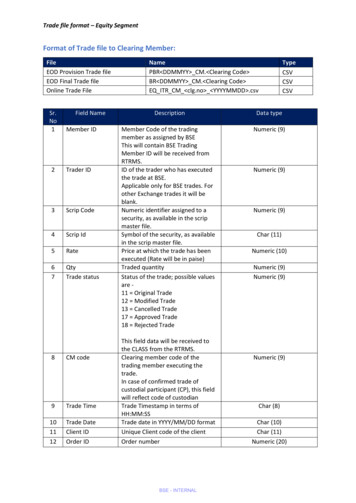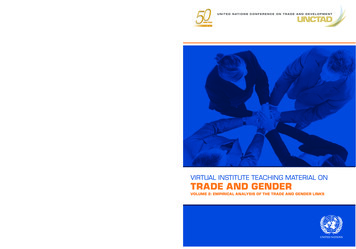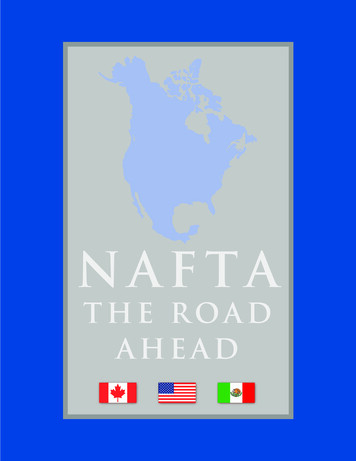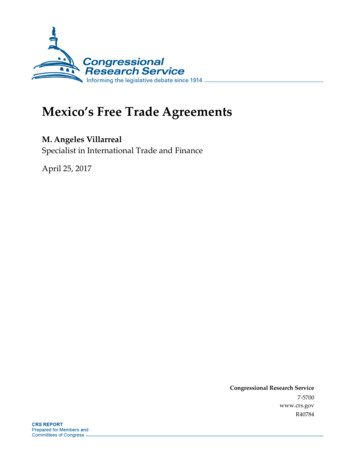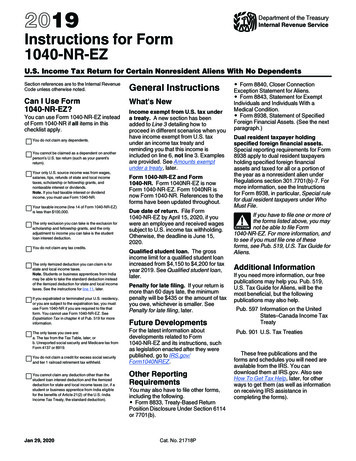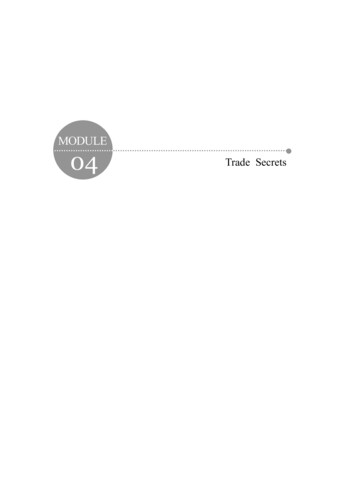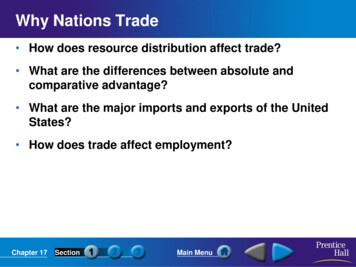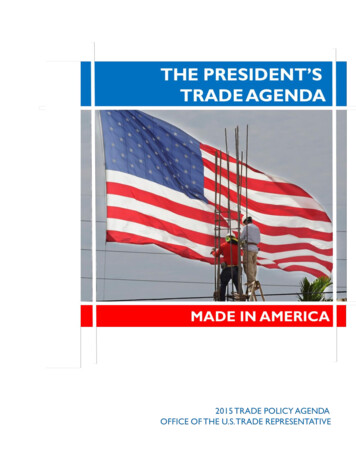
Transcription
IntroductionPresident Obama’s trade policy seeks to promote growth, support more well-paying jobsin the United States, and strengthen the middle class. Trade policy done right – throughproactive enforcement of existing agreements and the negotiation of new, high standardagreements – is among the nation’s best tools to address the challenges of globalizationand technological change and promote American interests and values.Trade has played an indispensable role in America’s recoveryfrom the Great Recession. Since the end of the recession inmid-2009, the increase in U.S. exports has contributed nearlyone-third of our overall economic growth. Last year, U.S.exports reached 2.35 trillion, a record-breaking amount thatsupported over 11 million good-paying American jobs. Withthose jobs paying up to 18 percent more than jobs not relatedto exports, trade policy has an important role to play inraising wages and living standards for the middle class.Partially as a result of our exporting success, our economycontinues to grow: Job creation is happening at the fastest ratesince the 1990s, and the budget deficit is falling at the fastestrate since the 1940s. After nearly two decades in decline,factories are opening in this country again and manufacturingjobs are starting to return from overseas.President Obama’strade policy seeks topromote growth,support more wellpaying jobs in theUnited States, andstrengthen themiddle class.
Today, “Made in America” is making a comeback: More American small businesses are exporting than ever before. American farmers are exporting more than ever before. American manufacturers and service providers are exporting more than ever before,with manufacturing growing faster than the rest of the economy.Behind these statistics are flesh-and-blood success stories for working families: the autoparts firm that would have closed its line and gone dark had it not been for overseasmarkets; the craftsman now finding customers around the world via the internet; and thetechnology company or the family farm that secured that new contract abroad. There arehundreds of thousands more stories like it.Yet despite the proven benefits of trade, there continues to be uneasiness around pursuingnew trade opportunities. That is understandable. Changes in technology and automation,combined with the continued pace of globalization, have increased pressure on wages andcontributed to the sense that there are fewer opportunities for working Americans.The concern is legitimate.The question is what are we going to do about it?Trade policy done right is how we protect American workers and jobs, create a more fairand level playing field, and ensure that it is the United States that leads in defining therules of the road. But the reality is that Americans are already competing against the rest ofthe world.
We already have one of the most open markets on theplanet. Our tariffs on imports are extremely low – less than1.5 percent on average – and we do not use non-tariffbarriers to prevent other countries from selling their goodsand services in the United States.Whether we continue to pursue trade agreements or not, theUnited States will continue to see foreign imports becauseconsumers demand them and we have virtually no barriersto imports.The same is not true for other countries, many of whichhave high tariffs and non-tariff barriers to discriminateagainst American products; provide unfair subsidies; andencourage development without concern for theenvironment or the rights of workers. All of these barriersseparate American producers from the 95 percent of globalconsumers who live outside our borders. That is whyAmerican trade agreements benefit American workers.We already have oneof the most openmarkets on theplanet.The same is not truefor other countries.That is why Americantrade agreementsbenefit Americanworkers.
Taking on the Status QuoIf the playing field is level and the competition is fair, American workers and businessescan and will win.The pace of globalization and technological change is not slowing down. We need to takeon that challenge. Consider this: in the last five years, the capacity of the world’s containerfleets has grown by 50 percent. The number of internet users has doubled and the amountof internet traffic has tripled. The world’s urban population has grown by hundreds ofmillions of people.These trends are not going away.
The question we face is not whether we can roll back the tide of globalization. It is whetherwe are going to shape it or be shaped by it, whether we are going to do everything we canto ensure that it reflects our interest and our values – or to let other countries define it forus.Americans do not passivelystand by. We engage.We shape. We lead.History tells us that there is an American tradition.Americans don’t passively stand by. We engage.We shape. We lead. That is precisely what we aredoing right now in trade.By leading on trade, the United States can level the playing field for our workers andbusinesses. We can knock down barriers to U.S. exports and raise standards around theworld. Both our interests and our values are at stake when it comes to protecting workerrights and the environment, promoting innovation and access to that innovation, andmaintaining a free and open Internet.That’s why we’ve insisted on putting the highest labor and environmental standards of anytrade agreement in the Trans-Pacific Partnership (TPP), which we’re negotiating with 11countries in the Asia Pacific. When completed, this agreement will boost middle classpaychecks here at home as well as working conditions and environmental protections inthe world’s fastest-growing region. In the Asia Pacific and elsewhere, we can give moreAmericans a fair shot in global markets by forging trade agreements that are progressiveand pro-growth.Taken together, these efforts constitute the mostambitious trade agenda in history – economically andstrategically. The United States already has a numberof strengths that make it an attractive place to investand do business, including a talented and productiveworkforce, strong rule of law, and increasinglyabundant sources of affordable energy. Through ourtrade agenda, we are seeking to put the United States atthe center of a trade zone covering nearly two-thirds ofthe global economy. That will help make America theworld’s production platform of choice, increasing U.S.exports and attracting more employers that want toinvest in the United States, hire American workers, andsell American goods and services to the world.Trade policy is a lever forencouraging investment inthe United States,creating more high-payingjobs, and combattingwage stagnation andincome inequality.In this sense, our trade policy is a lever for encouraging investment in the United States,creating more high-paying jobs and combatting wage stagnation and income inequality.
America’s Role in the WorldBy strengthening the U.S. economy – America’s foundation of power – our trade policyhelps to protect the strategic capabilities our economy supports. Increasingly, however, theeconomic clout that trade creates is itself an important source of influence in world affairs.Exercising that influence, this agenda advances three strategic objectives: strengtheningour partners and allies, establishing and enforcing rules of the road, and spurring broadbased, inclusive development.Trade agreements can build mutual strength with our partners and signal the importance ofthese partnerships to the world. For example, through the Transatlantic Trade andInvestment Partnership (T-TIP), we are deepening our economic relationship with theEuropean Union (EU), which is already the world’s largest and covers 1 trillion in annualtrade, 4 trillion in investment, and supports 13 million jobs on both sides of the Atlantic.At a time of geopolitical uncertainty on the periphery of Europe, the T-TIP reminds theworld that our transatlantic partnershipis second-to-none.Our agreements also bring stability tocritical regions in flux. A main pillarof our rebalance toward Asia, the TPPwill set rules of the road for nearly 40percent of the global economy,including the world’s fastest growingregion. It will strengthen habits ofcooperation among our partners. Andit underscores that the United States is– and always will be – a Pacificpower, and that our future is verymuch intertwined with the stabilityand prosperity of the Asia-Pacificregion.Our trade policy aims not only toupdate the global economic architecture but also to expand it through efforts like theAfrican Growth and Opportunity Act. The cornerstone of U.S. trade policy with subSaharan Africa since 2000, this program has supported job growth in Africa and the UnitedStates and created countless market opportunities for American businesses. Updating andrenewing our relationships to reflect changes within Africa and between African countriesand their trading partners would send a strong message that America remains deeplycommitted to this dynamic region and to promoting broad-based development throughtrade.Strategic objectives strongly reinforce the economic merits of trade. For example, workingwith developing nations to alleviate poverty and foster economic growth simultaneouslycreates better market opportunities for U.S. exporters. By leading on environmental, labor,
and other issues, we can launch a race to the top, rather than be subject to a race to thebottom. At a time when our open, rules-based system is competing against alternativemodels, advancing these objectives will help revitalize the global trading system, allowingthe United States to continue to play a leading role and ensuring that system reflectsAmerican interests and values.Our efforts in 2015 will build on successful 2014 initiatives. Last year, the United Statesmade substantial progress toward concluding the TPP. With the European Union, we madea fresh start in negotiations for the T-TIP. We played a critical role in realizing the firstfully multilateral trade agreement in the history of the World Trade Organization (WTO),the Trade Facilitation Agreement (TFA), and made significant progress in negotiations toexpand the scope of goods covered by the WTO Information Technology Agreement(ITA). Additionally, along with 13 other partners, we launched negotiations on theEnvironmental Goods Agreement (EGA) in Geneva.This will be a historic year for U.S. trade policy. In 2015, we will conclude negotiationswith TPP countries. We will make significant progress with the EU toward a T-TIPagreement to further strengthen the world’s largest trade relationship. We will advancenegotiations on the Trade in Services Agreement (TiSA). We will work with Congress toupdate and renew the African Growth and Opportunities Act (AGOA) for the longest termpossible. We will continue fighting for America’s trade rights, strengthening themultilateral trading system at the WTO, expanding the ITA, and continuing negotiationson an EGA. These are just some of the many areas where American leadership on tradewill increase U.S. exports to the world while supporting job growth here at home.To further strengthenAmerica’s ability to lead ontrade, President Obama hascalled on Congress to workwith him to secure approvalof bipartisan TradePromotion Authority(TPA). TPA is a criticaltool for Congress to updateand assert its role in tradepolicy and to guide currentand future negotiations.For more than 80 years,since the time of FDR,Democrats and Republicanshave worked together onsimilar measures to promote American exports and create jobs. This year, we have anopportunity to build on that tradition by modernizing TPA to address new issues and toupdate Congress’s role in trade policy.
Spotlight: Trade Promotion AuthorityTrade Promotion Authority is the product of decades of evolution during which timeCongress has strengthened its role in overseeing trade policy. The first trade authoritydates back to 1934, when the New Deal Congress allowed President Franklin D. Rooseveltto negotiate tariff reductions. Every American president has had trade negotiating authoritysince then, except Richard Nixon. The original trade negotiating authority allowed thePresident to enter into trade agreements without requiring subsequent Congressionalapproval. That was a delegation – and that’s not the way it’s done anymore.The first trade authority datesback to 1934, when the NewDeal Congress allowed FDR tonegotiate tariff reductions.Trade authority has beenrevised and reauthorized byCongress on 18 differentoccasions.In 1974, Congress passed new tradeauthority, establishing strong requirementsfor collaboration between Congress and theExecutive Branch, imposing specificnegotiating objectives and extensive newconsultation requirements on the ExecutiveBranch, while fully retaining Congress’sConstitutional prerogative to make all finaldeterminations about whether tradeagreements entered into law. Trade authorityhas been subsequently revised andreauthorized by Congress on 18 differentoccasions, by Congresses of both parties.PresidentLegislative ActionYearRoosevelt (D)Reciprocal Trade Agreements ActRenewalRenewalRenewalRenewalTrade Agreements Extension ActRenewalRenewalTrade Agreements Extension ActRenewalRenewalRenewalTrade Expansion ActTrade Expansion ActTrade ActTrade ActTrade Agreements ActTrade Agreements ActTrade and Tariffs ActOmnibus Trade ActOmnibus Trade ActRenewalTrade n (D)Eisenhower (R)Kennedy (D)Johnson (D)Ford (R)Carter (D)Reagan (R)Bush I (R)Clinton (D)Bush II atDemocratR Senate / D HouseDemocratDemocratDemocratD Senate / R House
Under TPA,Congress cedesno authority tothe President.Under TPA, Congress cedes no authority to the President.Presidents are always able to negotiate with foreign countries –but only Congress can implement a trade agreement. Congressretains all of its Constitutional authority and, as provided for inthe Constitution, either chamber of Congress can change itsprocedures at any time – including revoking TPA. This is exactlywhat House Democrats did in 2008 when they were unhappywith the outcome of trade negotiations.TPA was last updated in 2002. A lot has happened since then.As the economy changes, our approach to trade should change,too. New TPA legislation should address the digital economy,state-owned enterprises, and, for the first time ever, require bylaw that all future trade agreements include fully enforceablelabor and environmental provisions. TPA should be updated toreflect today’s economy. Through TPA, Congress sets veryclear priorities and objectives for the Executive branch, whileestablishing a set of notification and consultation proceduresthat allows the U.S. to speak with one voice in negotiations.TPA should beupdated toreflectCongressionalpriorities fortoday’s economy.Some call TPA “fast track” – but there is nothing fast about it.Most agreements take years to negotiate during which time theyundergo congressional scrutiny. First, Congress receives a 90 daynotification before negotiations begin with trading partners. Afteryears of negotiation, when negotiations are completed, Congressis provided another 90 day notification. Months later, whenimplementing legislation is introduced, Congress takes up to 90legislative days (typically several months) to hold hearings,about it.convene sessions for drafting implementing legislation, andultimately vote on agreements. Before implementing legislation heads to the floorCongressional Committees issue detailed reports, including on whether negotiatingobjectives have been met or not.Some call TPA“fast track” –but there isnothing fastAs Franklin Roosevelt said 80 years ago when he first asked for trade negotiatingauthority: “The world does not stand still.” In recent years, Asia-Pacific countries haveentered over 200 agreements, moving trade opportunities away from the United States andputting U.S. companies and workers at a disadvantage. China has been the largestbeneficiary. That is a status quo that is not acceptable. To keep strengthening our economy,we need better trade rules that protect American jobs and workers and that help us exportour goods around the world.It’s time to give the President the tools he has asked for – to bring home the mostprogressive trade agreements in history for U.S. workers. Approving an updated TPA isthe first step in that process.
The Path Not TakenWhat price would we pay in terms of U.S.interests and values if we were to abandonthe ambitious trade agenda proposed by thePresident?First, we would lose the opportunities tocreate new, high-paying jobs throughexpanded exports that are so important toour economic recovery. Other countrieswould get preferential access to some of thelargest and fastest-growing markets in theworld at our expense. Our firms would findthemselves at a disadvantage, creatingincentives for them to either drop out of thecompetition or move their productionoverseas to access those markets.Second, we would lose the opportunity tosecure enforceable commitments on laborand environmental standards – missing avaluable chance to promote core laborstandards and acceptable conditions ofwork; and diminishing our ability to protectthe marine environment, curb illegal andover-fishing, combat wildlife trafficking andillegal logging, and protect sensitive areas.Rather, we would cede the rule-setting toothers for whom protecting workers and theenvironment are not priorities.Third, we would limit both our ability toprotect American invention, artisticcreativity, and research, and our ability todevelop creative ways to speed the flow ofnew medicines to patients and further thefreedom of people to search, buy and createon the Internet. Rather, we would see anaccelerated rise of “data nationalism” and adigital world that begins to erect barriersrather than transcend them.Right now, there are 525 million middleclass consumers in Asia alone. By 2030,there are expected to be 3.2 billion middleclass consumers in Asia, more than 8 timesthe size of what the U.S. market is expectedto be at that time. Those consumers willwant better diets and more protein. Theywill want entertainment, games andsoftware. They will want to engage in ecommerce and order products from all overthe world. They will want to save and investfor their families’ future. They will want tobreathe clean air, drink clean water andsupport a sustainable environment. Theywill want clean energy products andequipment to build roads and schools. Theywill want cars and trucks and airplanes.Who will provide these goods and services?Will it be American workers, farmers andranchers, or their competitors from othercountries? Will we have access to marketsand terms on which we can compete, or willwe be left on the sidelines?Other countries are not standing by andwaiting for us to act. They are busynegotiating their own deals, trying to gainpreferential market access to countries,setting rules of the road that do not reflectour values. And they do not put theemphasis we do on raising labor andenvironmental standards, protectingintellectual property rights, promotingaccess to innovation, preserving the freedomof the Internet or putting disciplines onstate-owned enterprises.We face a choice: Work to raise the bar orstay on the sidelines as other countries writethe rules of the game. Promote a race to thetop or acquiesce to a race to the bottomwhich we cannot win and which our valuestell us we should not run. That is not in theinterest of America’s workers andAmerica’s families.
Job Creation and Economic GrowthIn 2015, the Administration will actively pursue a range of initiatives to expand globallycompetitive U.S. exports in our manufacturing and agriculture sectors. A revitalized U.S.manufacturing sector continues to play a key role in the future of our economy. As Americanmanufacturers grow our capacity to produce more advanced and value-added goods, consumersaround the world continue to place a high value on products made in America.In 2014, the United Statesexported 1.4 trillion ofmanufactured goods, whichaccounted for 86 percent of allU.S. goods exports and 60 percentof U.S. total exports.This strong performance supportsgood-paying U.S. jobs,contributing to the nearly 900,000manufacturing jobs that theeconomy has added since 2010.To further support the growth of advanced manufacturing and associated high-quality jobs hereat home, in 2015 the Obama Administration will continue to pursue trade policies aimed atkeeping American manufacturers competitive with their global peers.Throughout our trade negotiations, we aim todiscipline the use of trade and regulatory measuresthat create barriers to U.S. exports, level the playingfield between SOEs and private firms, ensure thatrules of origin promote manufacturing in the UnitedStates, and increase the efficiency of the globalsupply chain and thereby create incentives formanufacturers to locate in the United States.As the U.S. knowledge and innovation economycontinues to grow in the 21st century, we havebecome the world's largest trader in services. For theUnited States, services account for over threequarters of U.S. private sector GDP and four out offive jobs. Thanks to a vibrant and open domesticmarket, the United States is highly competitive inservices trade, routinely recording an annual surpluson the order of 200 billion. With every 1 billion inservices exports supporting an estimated 7,000 U.S.jobs, expanding services trade globally will unlocknew opportunities for Americans.
How Are Export-Intensive Industries Different?Higher Wages, Higher Productivity, Higher Value-AddedSince the beginning of the Obama Administration, the agricultural sector has been a bright spotfor exports, estimated to support more than one million American jobs throughout the U.S.agricultural supply chain. In 2014, the United States exported another record amount of 155.1billion of food and agricultural goods to consumers around the world.In 2015, the Administration will continue tofocus on combatting the growing number ofunwarranted Sanitary and Phytosanitary(SPS) barriers to trade by advocating forscience-based standards in support ofadditional exports of U.S. food andagricultural products. To realize the fullbenefits of our existing trade agreements, wewill continue to use the consultativemechanisms established in each agreementto ensure that all relevant commitments areupheld. Our efforts in agriculture also willinclude an ongoing push in plurilateraldiscussions on aligning regulatoryapproaches affecting trade in productsderived from modern biotechnology bybuilding alliances with like-minded countriesand utilizing international standardsorganizations both to grow U.S. agriculturalexports and to improve global food security.
Spotlight: ManufacturingAfter more than a decade of job losses, we’ve added nearly 900,000 manufacturing jobs overfive straight years of job growth. U.S. manufacturing is now growing at nearly twice the rateof the economy, the longest sustained period of outpacing the economy since the 1960s.Manufacturing output has increase 30 percent since the end of the recession, contributing togrowing manufacturing exports.Manufacturing Exports Continue to GrowU.S. manufacturing plays an outsized role insupporting and driving American innovation,and increasingly our ability to manufactureundergirds our future ability to innovate.Nearly 900,000 newmanufacturing jobsIf the U.S. manufacturing sector were acountry, it would be the 9th largest economy inthe world. 1 out of every 7 American privatesector workers works in a job supported bymanufacturing.Record manufacturing exportsAt the same time, U.S. companies are lookingto move production back to the United Statesfrom China. 54 percent of companiessurveyed in 2013 were actively consideringmoving manufacturing back from China to theU.S. – nearly a 50 percent increase over 2012.Manufacturing growing at twice therate of the economy – fastestgrowth since the 1960sU.S. ranked the best place to investfor the first time since 2001
Spotlight: AgricultureIn 2014, exports of U.S. food and agricultural products reached a record 155.1 billion – theculmination of the strongest six year period of agricultural exports in our nation’s history.Since 2009, U.S. agricultural exports have increased by roughly 53 percent.Agricultural Exports Continue to GrowExports are economically crucial to rural communities because exports generate 20 percent offarm income for U.S. agricultural producers and support over a million American jobs. In2013, every dollar of agricultural exports stimulated another 1.22 in business activity.The United States exports: Half of our wheat, milled rice, andsoybean production70 percent of our almonds,walnuts, and pistachiosMore than 75 percent of our cotton40 percent of our grapes20 percent of our apples20 percent of our poultry and porkAnd 10 percent of our beef
Spotlight: Small BusinessAmerica’s 28 million small businesses are the backbone of the U.S. economy, and the primaryengines of growth and innovation. Small businesses accounted for nearly two-third of newprivate sector jobs in recent decades, continued export growth for small businesses is a keypriority. While 98 percent of U.S. all businesses that export are small businesses, less than 10percent of U.S. small businesses – around 300,000 small businesses – export. That means weare well below our full small businesses exporting potential. Small businesses that exportgrow faster, create more jobs, and pay higher wages.The trade agreements the Obama Administration isnegotiating support small businesses by:1. Removing barriers to exports by cutting tariffs andreducing non-tariff barriers.2. Simplifying trade by including meaningful tradefacilitation provisions, creating simplified and expeditedcustoms rules, and applying strong and common rules oforigin.3. Facilitating small business engagement with globalmarkets by promoting e-commerce and digital trade, andensuring that provisions support SMEs.Number of Small Business Exporters By evadaNew HampshireNew JerseyNew MexicoNew YorkNorth CarolinaNorth lahomaOregonPennsylvaniaRhode IslandSouth CarolinaSouth est 63
High Standard, Job-SupportingTrade AgreementsTrade’s contribution to the U.S. economy has never been more significant than it is today. Tradesupports higher-paying jobs, spurs economic growth, and enhances the competitiveness of theU.S. economy. Last year, the United States exported 2.35 trillion in goods and services, settinga new record for the fifth year in a row. Over the last five years, U.S. exports have accounted fornearly a third of total U.S. economic growth.These economic gains pay real dividends for real people. Since 2009 under President Obama,U.S. exports have increased by nearly 50 percent, growing two and a half times faster than theeconomy as a whole, adding 762 billion dollars to our economic output and contributing nearlya third of our total economic growth.Exports to countries wehave free tradeagreements with havesignificantly outpacedexports to countrieswhere we do not havetrade agreements.Rising exports have been strengthening communities acrossAmerica by supporting more high-paying jobs. Each billiondollars of increased exports supports over 5,000 jobs, onaverage. Between 2009 and 2014, exports supported anestimated 1.8 million additional private sector jobs – jobsthat pay up to 18 percent more on average than non-exportrelated jobs. Today, more than 300,000 Americancompanies export, 98 percent of which are small andmedium size businesses.Trade agreements have played an important role inincreasing U.S. exports. Over the past five years, exports ofU.S. goods to our free trade agreement (FTA) partners increased over 64 percent, significantlyoutpacing the increase of around 45 percent to our non-FTA partners. Altogether, FTA partnersaccounted for nearly half of total U.S. goods exports to the world in 2014. Despite running anoverall trade deficit, the United States runs a goods andservices trade surplus with our combined 20 FTA partners.The United States runs aOur trade deficit, which has shrunk by a third since 2006, istrade surplus with ourcomprised largely of the trade balance with our non-FTApartners.combined 20 tradeIt’s in our interest to build on this progress, because theagreement partners.United States is already an open economy. Our averageapplied tariff is less than 1.5 percent, among the lowest in the world, and we don’t useregulations as a barrier to trade. America is open for business, but other countries still have realobstacles, tariff and non-tariff barriers, to our exports. As a result of that imbalance, our tradeagreements disproportionately reduce other countries’ barriers, allowing us to increase exportsand the good-paying jobs they support. That’s why it’s essential for the United States to continueto pursue an ambitious trade agenda.
Spotlight: The Success of Existing AgreementsU.S. Trade Surplus withFree Trade Agreement Partners(in Billions, excluding energy products)The U.S. has atrade surplus withour combined FTApartners.T
Americans a fair shot in global markets by forging trade agreements that are progressive and pro-growth. Taken together, these efforts constitute the most ambitious trade agenda in history – Trade policy is a lever for economically and strategically. The United States already has a numbe

